James Marion Sims Statue in New York
Introduction
Text-to-speech Audio
Images
The James Marion Sims statue located in Central Park.
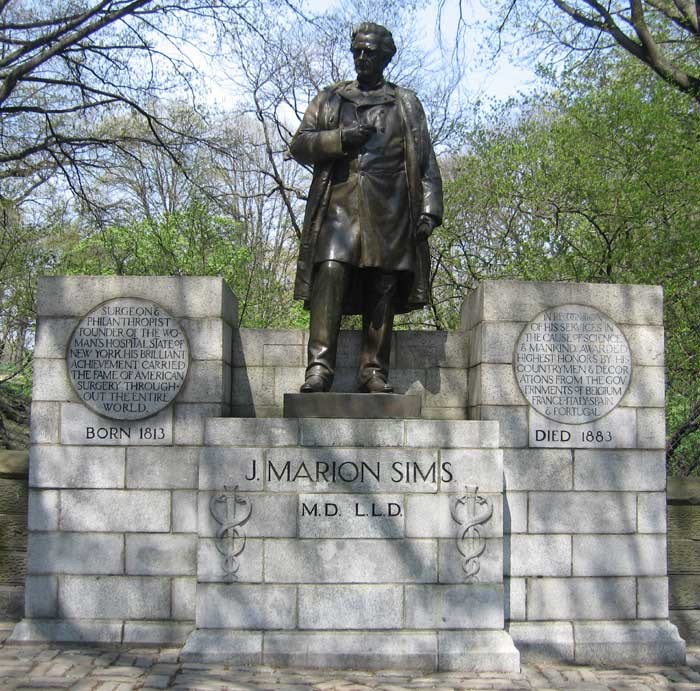
The first plaque on the statue that explains Sims's past fame as a physician.
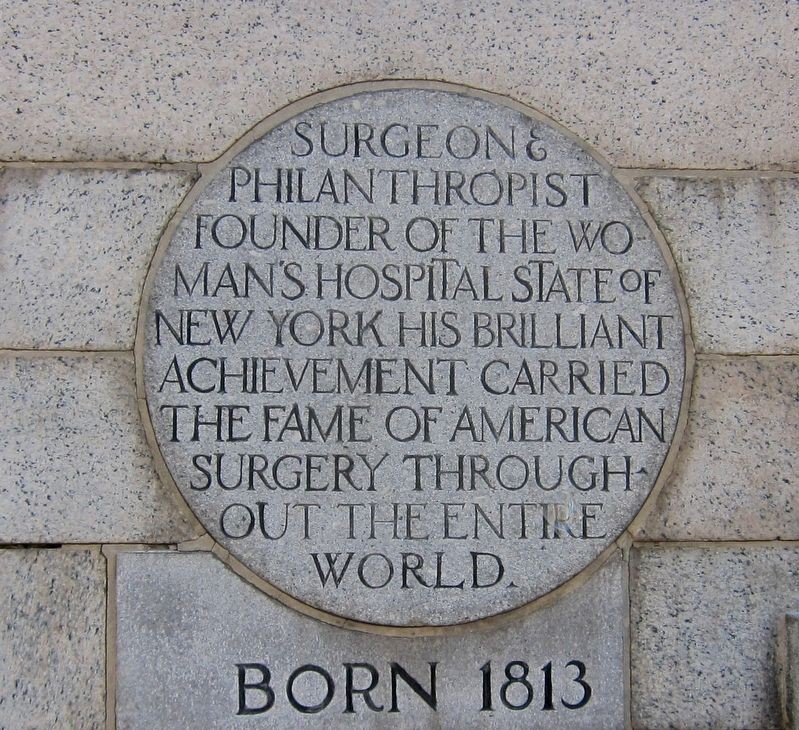
The second plaque on the statue that explains Sims's international fame.
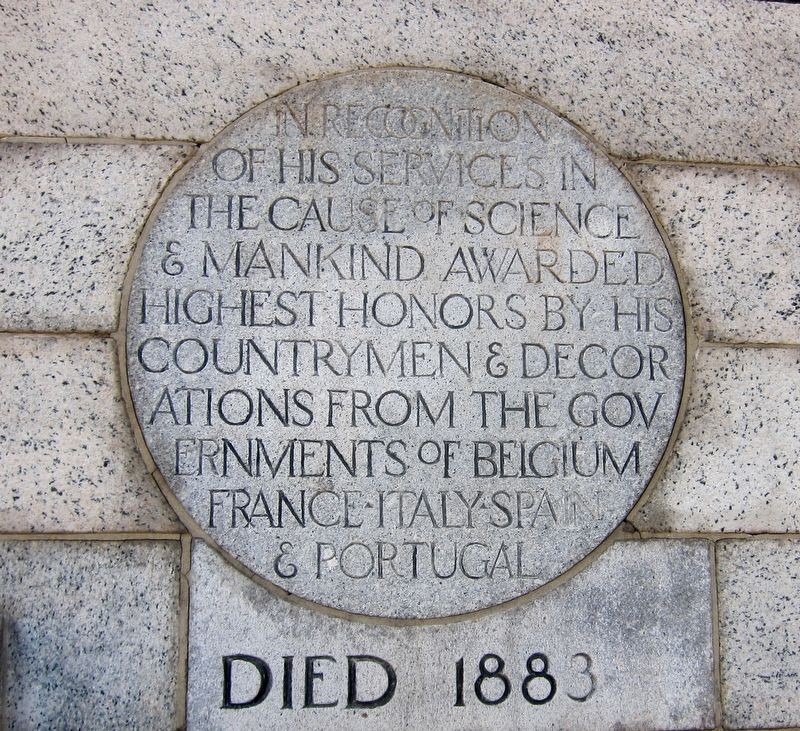
A speech given by Paul Mundé for the unveiling of the James Marion Sims statue in Bryant Park.
An article from the Journal of the American Medical Association about the unveiling of the statue in Bryant Park.
Black women from the Black Youth Project 100 protesting for the removal of the statue.
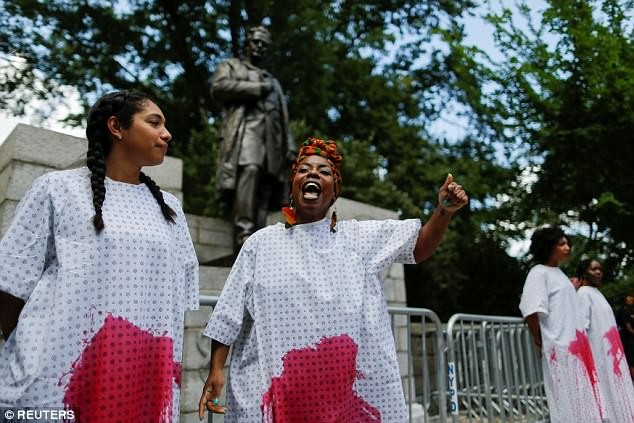
A New York Times article about the removal of the statue.
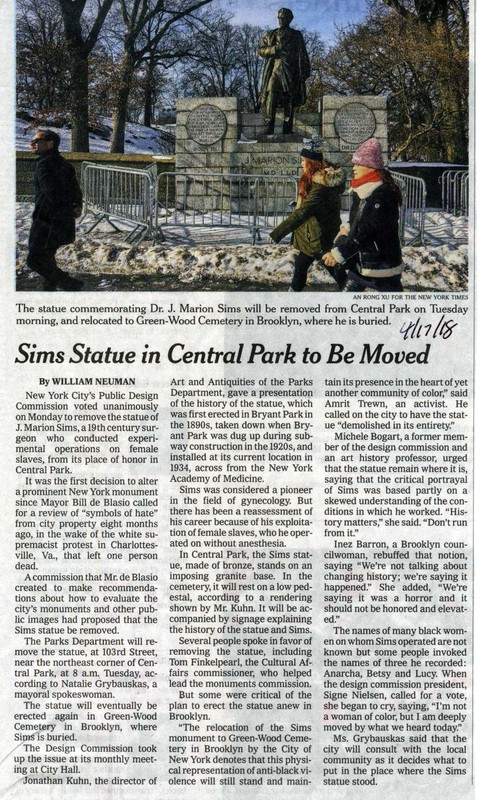
In good spirits, members of the East Harlem Preservation stand in front of the newly removed statue.
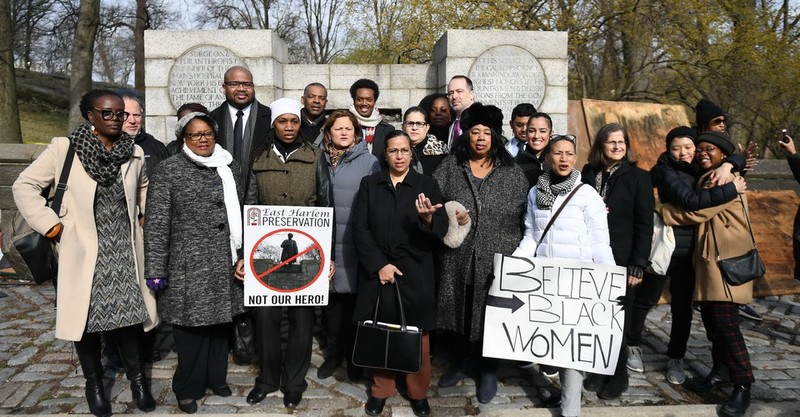
Backstory and Context
Text-to-speech Audio
The New York statue of James Marion Sims was crafted about nine years after the Sims had passed in 1883. The statue was originally made in Munich, Germany by Ferdinand von Miller II. (1) The intent behind the statue was to honor Sims’s medical achievements. His most prevalent achievement was his surgical method to cure vesicovaginal fistulas, which are a labor complication that creates an opening between the vagina and the bladder. Sims operated on three enslaved women named Anarcha, Betsey, and Lucy to develop this method.
The statue was first commemorated in 1894 in Bryant Park, but the statue has been relocated multiple times for contradictory reasons. In 1934, the statue was first relocated to Central Park, the location where the monument stood for the longest. (1) The statue was moved to be near the New York Academy of Medicine. Due to complaints of Sims’s ethical choices during his surgical experiments, the statue was uprooted from its pedestal and repositioned near his grave in Green-Wood Cemetery in Brooklyn, New York in April of 2018. (2) The pedestal remains in Central Park to this date.
Throughout Sims’s career, the public did not question the ethics behind Sims’s medical experiments. The public’s admiration for him thrived even after his death. He was an inspiration to the medical community for his modern innovations in gynecology and founding the first Women’s Hospital in the United States. (1)
Before Sims gained popularity, he never envisioned himself specializing in gynecology. He would often turn down patients that required treatment in women’s health and would instead recommend other physicians. (3) The first aspect of gynecology that sparked Sims’s interest was vesicovaginal fistulas. Sims’s surgical experiments for fistulas started after he felt inspired by one of his patients who had a retroverted uterus and injured pelvis after falling off a horse. (3) Sims and a few of his acquaintances had made a deal together that would result in Sims’s future fame and hatred by the public.
Sims proposed that he would practice new surgical techniques on the acquaintance’s enslaved women as long as the owner provided the women with clothes and paid their taxes. (3) Anarcha, Betsey, and Lucy were the three main women that were traded in this deal. In the agreement, Sims stated how he would not perform any experiment that jeopardized the women's lives. (3) Although, Sims openly admitted that there was a moment where he was convinced that Lucy was going to die due to her from her expression of pain. Sims experimented on these women with different techniques for approximately five years to develop a surgical technique to cure a vesicovaginal fistula.
In a speech given by Paul Mundé at the unveiling of Sims’s statue in Bryant Park, Mundé described Sims’s innovation as a gift that improved medicine for the future generations. (4) Mundé speaks on how Sims was not solely admired by the South or New York, but instead, Sims was held on a pedestal by many European countries. (4) The statue of Sims in Bryant Park was a historic moment for the medical community. The Journal of the American Medical Association wrote about Sims’s accomplishments and his newly established statue on November 3, 1894. The journal also stated how the New York statue was the first statue of a medical professional created in the United States. (5) This journal even claimed how the statue’s plaque is an extremely accurate way to represent Sims as a surgeon. A great summary of how the public used to view Sims from the journal states, “The medical profession of the world is better and nobler for having once had a Sims and it is well to honor his memory,”. (5)
During this period, the public viewed Sims's surgical innovation as one-sided. Anarcha, Betsey, and Lucy were never mentioned as a key element towards Sims’s surgical advancements. They were quickly forgotten while Sims’s fame grew larger.
As societal norms changed, the public’s feelings that were expressed for Sims did as well. One of the first individuals to call out Sims’s choices as a physician was Viola Plummer in 2006. (2) Plummer’s issue with Sims was founded on the lack of consent and Sims’s decision to not use anesthesia on Anarcha, Betsey, and Lucy.
Since anesthesia was not widely used and fairly new, Anarcha, Betsey, and Lucy were not operated on with anesthesia. (1) Many physicians did not feel comfortable utilizing anesthesia if they were not informed on how to use it properly. They did not believe the pain caused by the surgical techniques was worth the risk of using a new method like anesthesia. Sims instead gave women pain killer medicine that is highly addictive.
Since Anarcha, Betsey, and Lucy were enslaved, there was not an opportunity for them to give consent. The only consent that Sims needed was from their owners. In the autobiography that Sims wrote, he mentioned how he did receive consent from Betsy, but there is not another source that includes Betsy’s honest perspective.
In addition to Plummer’s activism, Harriet A. Washington released Medical Apartheid in 2006 that discusses the effects that Sims experimentation had on future African-Americans as patients. (2) Both activists inspired the East Harlem Preservation to create campaigns to get this statue removed. Various in-person protests against his statue in Central Park started in 2010. 26,000 signatures were collected in hopes to have this monument partially removed from Central Park. (2)
Bill de Blasio, the mayor of New York City, decided in January of 2018 that the monument should be partially relocated. In April of 2018, the statue was relocated to stand near Sims’s grave. (2) The relocation of the statue stirred up a variation of opinions from the public. Some are satisfied with the change while others had other envisions for the statue’s future. Some individuals felt that the statue should be destroyed, and a statue of a physician of color should replace his statue. While others argue that destroying the statue would be erasing a part of history society does not want to repeat.
Cite This Entry
Melissa Acosta. "James Marion Sims Statue in New York ." Clio: Your Guide to History. May 19, 2020. Accessed March 18, 2025. https://theclio.com/entry/103107
Sources
(1) “Dr. James Marion Sims Sculpture.” Historical Sign Listings: NYC Parks. NYC, April 16, 2018. https://www.nycgovparks.org/about/history/historical-signs/listings?id=13315.
(2) Sayej, Nadja. “J Marion Sims: Controversial Statue Taken down but Debate Still Rages.” The Guardian. Guardian News and Media, April 21, 2018.
(3) Sims, J., and Marion-Sims, H. The Story of My Life. D. Appleton and Company, 1886.
(4) “DR. J. MARION SIMS--THE FATHER OF MODERN GYNECOLOGY: BEING AN ADDRESS DELIVERED OCTOBER 20, 1894, IN BRYANT PARK, NEW YORK, ON THE UNVEILING OF THE STATUE OF DR. J. MARION SIMS.” ProQuest. ProQuest. Accessed March 19, 2020. https://search.proquest.com/openview/c22cb395f3126fb16261a3f2cf34cf9d/1?pq-origsite=gscholar&cbl=40146.
(5) "THE STATUE OF DR. J. MARION SIMS IN BRYANT PARK." Journal of the American Medical Association XXIII, no. 18 (1894): 689-90.
https://ahrp.org/1845-1849-j-marion-sims-the-father-of-gynegology/dr-j-marion-sims/
https://www.hmdb.org/m.asp?m=98627
https://www.hmdb.org/m.asp?m=98627
https://search.proquest.com/openview/c22cb395f3126fb16261a3f2cf34cf9d/1?pq-origsite=gscholar&cbl=40146.
https://expressdigest.com/new-york-protesters-want-removal-of-j-marion-sims-statue/
https://www.hmdb.org/m.asp?m=98627
https://www.theatlantic.com/politics/archive/2018/04/why-a-statue-of-the-father-of-gynecology-had-to-come-down/558311/

